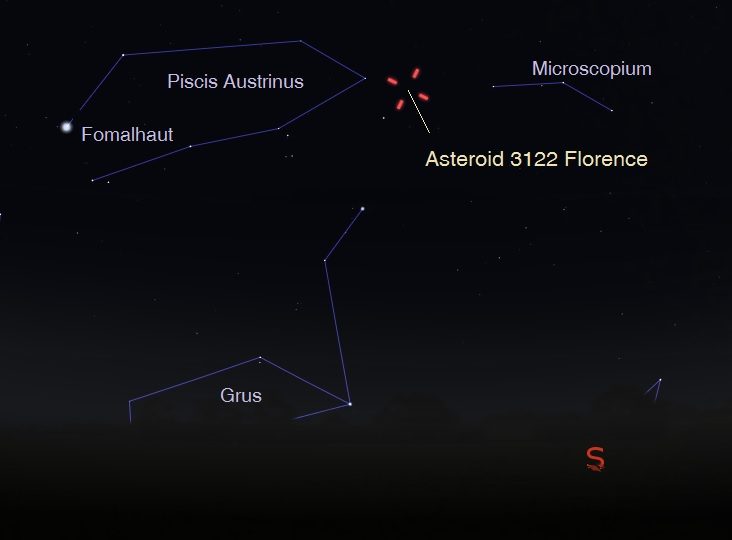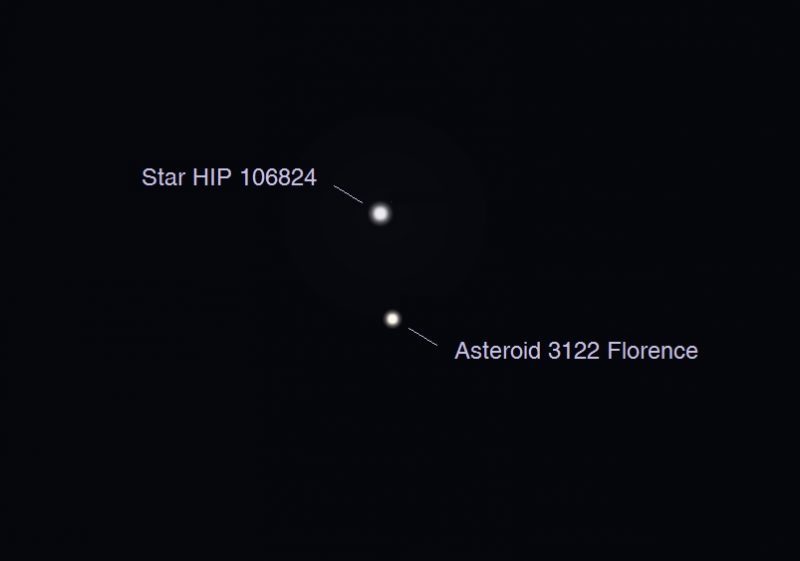
Florence is the largest asteroid to pass this close to our planet since the first near-Earth asteroid was discovered over a century ago.Asteroid 3122 Florence will safely pass by our planet on September 1, 2017 at over 18 times the Earth-moon distance. The asteroid will not be visible to the unaided eye. It will, however, become visible in small amateur telescopes by late August, in the course of what will become the closest encounter to Earth by this asteroid since 1890.

Of these, however, Florence is brightest, making it an excellent target for possible glimpses via small telescopes and binoculars.
Its size of about half the elevation of Mount Everest should allow it to reach a visual magnitude of +8.75 to +9, making it a relatively easy target for experienced observers at sites with dark skies.
Astronomers will study the flyby of the huge asteroid. Radar observations are scheduled from NASA's Goldstone Radar between August 29 to September 8, 2017. The Arecibo Observatory will also analyze Florence from September 2 - 5, 2017. Paul Chodas of the Center of NEO Studies said:
The September 1 flyby of Florence will provide astronomers with an excellent opportunity to make detailed measurements of a large near-Earth asteroid. In particular, radar scientists expect to obtain high-resolution images of Florence that could reveal surface features as small as about 10 meters (30 feet).The asteroid rotates in about 2.5 hours and radar observations may reveal if Florence is a close or contact binary, or even if the space rock has its own small orbiting "moon."
Closest approach to Earth is expected to occur at about 8:06 am EDT on September 1, 2017, but backyard observers using a telescope can try to get a glimpse of the space rock a few nights before that date.
On the night of August 27, the asteroid is in the constellation of Piscis Austrinus reaching about 19º above the southern horizon as seen from central U.S. Late in the night of August 29, the space rock gets into Capricornus and reaches an elevation of 33º as seen from Kansas.
Its distance will make it difficult to detect its slow motion across the stars, unless you are using at least a 5″ diameter or bigger telescope and observe in the right direction.
Although asteroid Florence is travelling at 30,266 miles per hour (48,708 km/h), the distance will make it appear so slow that observers should keep watching the fairly bright asteroid for about 5 to 10 minutes to detect its movement across the stars.
Florence was discovered on March 2, 1981 from the Siding Spring Observatory in Australia. It is named in honor of Florence Nightingale (1820-1910), the founder of modern nursing.
Bottom line: Asteroid 3122 Florence will safely pass by our planet on September 1, 2017 at over 18 times the Earth-moon distance. It's the largest asteroid to pass this close to our planet since the first near-Earth asteroid was discovered over a century ago and might be visible to observers at dark sites using small telescopes, and even binoculars.




Reader Comments
to our Newsletter